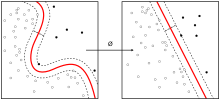
Long short term memory

Long short-term memory (LSTM) is an artificial recurrent neural network (RNN) architecture used in the field of deep learning. Unlike standard feedforward neural networks, LSTM has feedback connections. It can not only process single data points (such as images), but also entire sequences of data (such as speech or video). For example, LSTM is applicable to tasks such as unsegmented, connected handwriting recognition or speech recognition.Bloomberg Business Week wrote: 'These powers make LSTM arguably the most commercial AI achievement, used for everything from predicting diseases to composing music.' Long short-term memory (LSTM) is an artificial recurrent neural network (RNN) architecture used in the field of deep learning. Unlike standard feedforward neural networks, LSTM has feedback connections. It can not only process single data points (such as images), but also entire sequences of data (such as speech or video). For example, LSTM is applicable to tasks such as unsegmented, connected handwriting recognition or speech recognition.Bloomberg Business Week wrote: 'These powers make LSTM arguably the most commercial AI achievement, used for everything from predicting diseases to composing music.' A common LSTM unit is composed of a cell, an input gate, an output gate and a forget gate. The cell remembers values over arbitrary time intervals and the three gates regulate the flow of information into and out of the cell. LSTM networks are well-suited to classifying, processing and making predictions based on time series data, since there can be lags of unknown duration between important events in a time series. LSTMs were developed to deal with the exploding and vanishing gradient problems that can be encountered when training traditional RNNs. Relative insensitivity to gap length is an advantage of LSTM over RNNs, hidden Markov models and other sequence learning methods in numerous applications. LSTM was proposed in 1997 by Sepp Hochreiter and Jürgen Schmidhuber. By introducing Constant Error Carousel (CEC) units, LSTM deals with the exploding and vanishing gradient problems. The initial version of LSTM block included cells, input and output gates. In 1999, Felix Gers and his advisor Jürgen Schmidhuber and Fred Cummins introduced the forget gate (also called “keep gate”) into LSTM architecture, enabling the LSTM to reset its own state. In 2000, Gers & Schmidhuber & Cummins added peephole connections (connections from the cell to the gates) into the architecture. Additionally, the output activation function was omitted. In 2014, Kyunghyun Cho et al. put forward a simplified variant called Gated recurrent unit (GRU). Among other successes, LSTM achieved record results in natural language text compression, unsegmented connected handwriting recognition and won the ICDAR handwriting competition (2009). LSTM networks were a major component of a network that achieved a record 17.7% phoneme error rate on the classic TIMIT natural speech dataset (2013). As of 2016, major technology companies including Google, Apple, and Microsoft were using LSTM as fundamental components in new products. For example, Google used LSTM for speech recognition on the smartphone, for the smart assistant Allo and for Google Translate. Apple uses LSTM for the 'Quicktype' function on the iPhone and for Siri. Amazon uses LSTM for Amazon Alexa.
